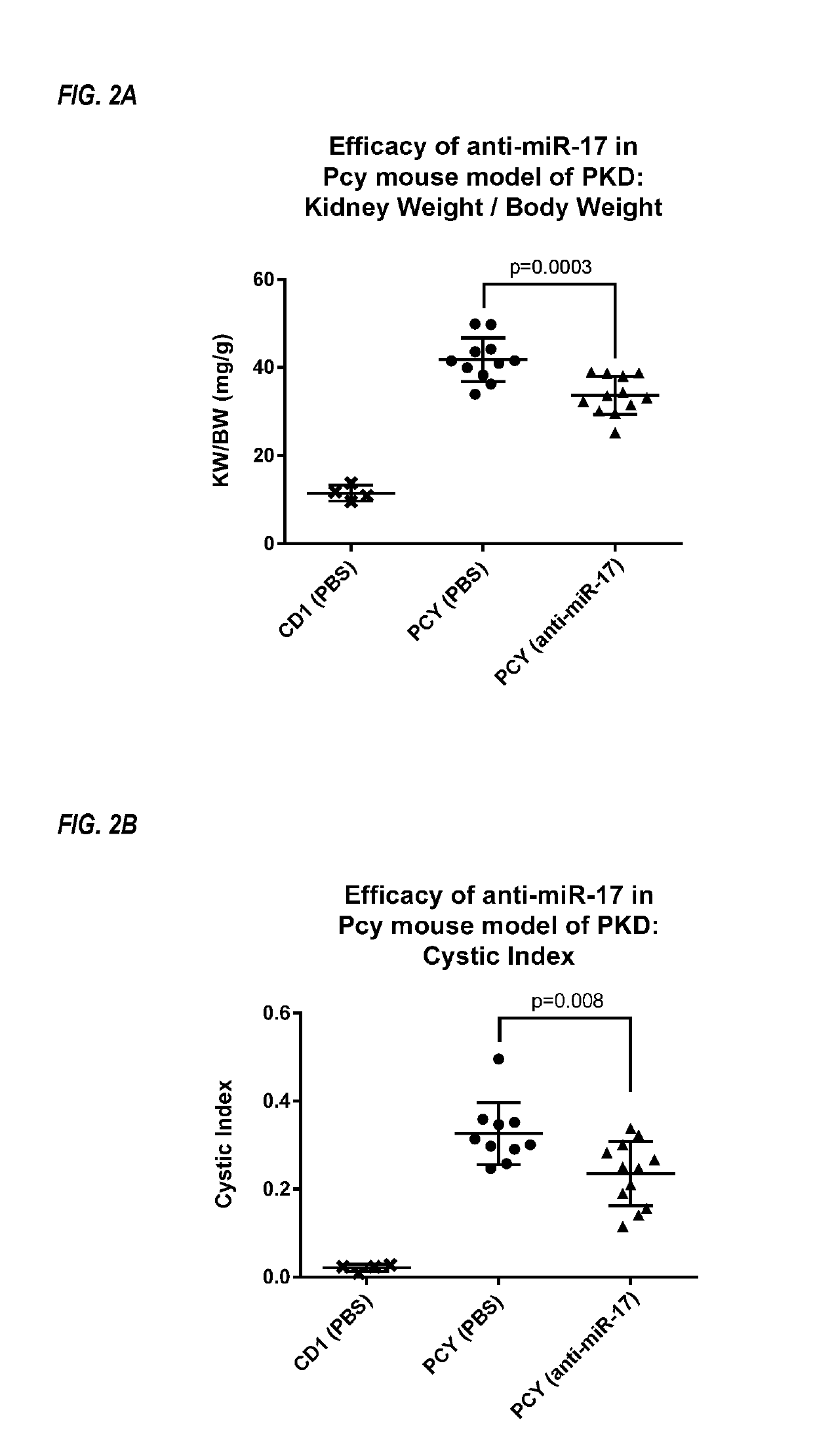Methods for treatment of polycystic kidney disease
a polycystic kidney and kidney disease technology, applied in the field of polycystic kidney disease treatment, can solve the problems of no approved therapeutic agent, achieve the effects of improving kidney function, increasing total kidney volume, and improving kidney function
- Summary
- Abstract
- Description
- Claims
- Application Information
AI Technical Summary
Benefits of technology
Problems solved by technology
Method used
Image
Examples
example 1
Anti-miR-17 in a Model of Polycystic Kidney Disease
[0262]Pkhd1 / cre;Pkd2F / F mice spontaneously develop polycystic kidney disease, and were used as a model of ADPKD. See Patel et al., PNAS, 2013; 110(26): 10765-10770.
[0263]A modified oligonucleotide complementary to miR-17 (anti-miR-17 compound) was tested in the Pkhd1 / cre;Pkd2F / F mouse model of ADPKD. Wild-type mice were used as control mice. An oligonucleotide complementary to a miRNA unrelated to miR-17 was used as a treatment control for specificity (anti-miR-control). The anti-miR-17 compound was a fully phosphorothioated oligonucleotide 19 linked nucleosides in length (5′-CTGCACTGTAAGCACTTTG-3′; SEQ ID NO: 15), with DNA, 2′-MOE and S-cEt sugar moieties.
[0264]From 10 to 12 days of age, sex-matched littermates of mice were treated with anti-miR-17 (20 mg / kg) or PBS, for a total of three daily doses. At 19 days of age, the mice were treated with a fourth dose of anti-miR-17 (20 mg / kg) or PBS. Anti-miR-17 was administered subcutaneo...
example 3
Inhibition of miR-17 Family Members
[0272]A number of microRNAs share seed sequence identity, and are thus members of a microRNA family. As the seed region of a microRNA is determining factor for target specificity, microRNA family members often regulate similar sets of messenger RNA targets. Outside the seed region, microRNA family members share varying degrees of sequence identity.
[0273]One such family is the miR-17 family, which includes miR-17, miR-20a, miR-20b, miR-93, miR-106a, and miR-106b. The individual microRNAs of this microRNA family are located on three different chromosomes, within three different microRNA clusters. miR-17 and miR-20a reside within the miR-17˜92 cluster on human chromosome 13; miR-20b and miR-106a reside within the miR-106a-363 cluster on the human X chromosome, and miR-93 and miR-106b reside within the miR-106b-25 cluster on human chromosome 7 (FIG. 1A). Each of these three clusters contains other microRNAs that are not members of the miR-17 family, an...
example 4
miR-17 Inhibition in Human ADPKD Cysts
[0278]The effects of miR-17 inhibition were studied in primary cultures derived from human ADPKD cysts. Frozen human primary ADPKD cells were provided by the PKD Research Biomaterials and Cellular Models Core at the Kansas University Medical Center (KUMC) Human primary ADPKD cells were grown in DMEM:F12 medium (Gibco) supplemented with 5% FBS, 5 ug / ml insulin, 5 ug / ml transferrin and 5 ng / ml sodium selenite (ITS) (Lonza), as previously described (Yamaguchi et al., Am J Physiol Renal Physiol, 2010, 299: F944-951).
[0279]Proliferation Assay
[0280]At 80% confluency, human ADPKD cells were trypsinized using 1:10 dilution of Trypsin in Ca+2 and Mg+2 free PBS. Cells were transfected with RNAiMAX (Life Technologies) following the manufacturer's protocol at a density of 2500 cells / well in a 96-well plate. Treatments were as follows:[0281]anti-miR-17 (at doses of 3 nM, 10 nM, or 30 nM; n=5 for each treatment)[0282]control oligonucleotide (at doses indicate...
PUM
| Property | Measurement | Unit |
|---|---|---|
| volume | aaaaa | aaaaa |
| weight | aaaaa | aaaaa |
| weight ratio | aaaaa | aaaaa |
Abstract
Description
Claims
Application Information
 Login to View More
Login to View More - R&D
- Intellectual Property
- Life Sciences
- Materials
- Tech Scout
- Unparalleled Data Quality
- Higher Quality Content
- 60% Fewer Hallucinations
Browse by: Latest US Patents, China's latest patents, Technical Efficacy Thesaurus, Application Domain, Technology Topic, Popular Technical Reports.
© 2025 PatSnap. All rights reserved.Legal|Privacy policy|Modern Slavery Act Transparency Statement|Sitemap|About US| Contact US: help@patsnap.com



